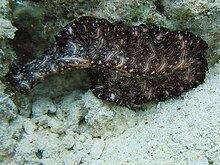
Nemertea is a phylum of animals also known as ribbon worms or proboscis worms, consisting of 1300 known species. Most ribbon worms are very slim, usually only a few millimeters wide, although a few have relatively short but wide bodies. Many have patterns of yellow, orange, red and green coloration. The foregut, stomach and intestine run a little below the midline of the body, the anus is at the tip of the tail, and the mouth is under the front. A little above the gut is the rhynchocoel, a cavity which mostly runs above the midline and ends a little short of the rear of the body. All species have a proboscis which lies in the rhynchocoel when inactive but everts to emerge just above the mouth to capture the animal's prey with venom. A highly extensible muscle in the back of the rhynchocoel pulls the proboscis in when an attack ends. A few species with stubby bodies filter feed and have suckers at the front and back ends, with which they attach to a host.

Acoelomorpha is a subphylum of very simple and small soft-bodied animals with planula-like features which live in marine or brackish waters. They usually live between grains of sediment, swimming as plankton, or crawling on other organisms, such as algae and corals. With the exception of two acoel freshwater species, all known acoelomorphs are marine.

Acoela, or the acoels, is an order of small and simple invertebrates in the subphylum Acoelomorpha of phylum Xenacoelomorpha, a deep branching bilaterian group of animals, which resemble flatworms. Historically they were treated as an order of turbellarian flatworms. About 400 species are known, but probably many more not yet described.

Pseudocerotidae is a family of flatworms which includes the Bedford's flatworm. Pseudocerotidae are simple organisms categorized by their oval bodies and tentacles and bright colors. They use the cilia to glide along surfaces. Most commonly referred to as marine flatworms, closely related to the orders Macrostomorpha and Lecithoepitheliata. These organisms have very complex reproductive systems, no blood systems or organs for gas exchange, a simple brain and are hermaphroditic.
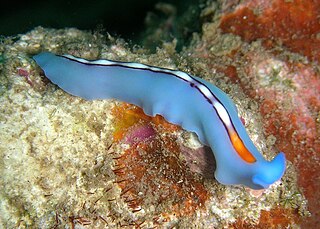
Pseudoceros is a genus of the flatworms Platyhelminthes.

Bispira brunnea, the social feather duster or cluster duster, is a species of marine bristleworm. They tend to live in groups of individuals, and are common off the Caribbean islands in southeast North America. The feather duster has one crown of various colors, however, the color of the crown seems to be consistent within individual colonies.

Yungia is a genus of flatworms.
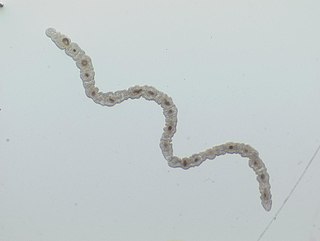
Catenulida is an order of flatworms in the classical classification, or a class of flatworms in a phylogenetic approach. They are relatively small free-living flatworms, inhabiting freshwater and marine environments. There are about 100 species described worldwide, but the simple anatomy makes species distinction problematic.

Pseudoceros ferrugineus, the Fuchsia flatworm, is a marine flatworm species that belongs to the Pseudocerotidae family.
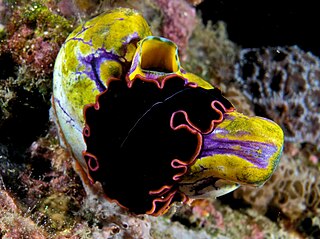
Cotylea is a suborder of free-living marine turbellarian flatworms in the order Polycladida.
Amakusaplana acroporae, the Acropora-eating flatworm or AEFW, is a species of free-living marine polyclad flatworms in the genus Amakusaplana.

Arnold Lang was a Swiss naturalist, a comparative anatomist and student of German biologist Ernst Haeckel.

Imbira is a genus of land planarians found in South America.

Callioplana is a genus of flatworm polyclads belonging to the Callioplanidae family.
Diana Marcela Bolaños Rodríguez is a Colombian marine biologist who has studied and classified various types of platyhelminths. She was a recipient of the L'Oréal-UNESCO Fellowship for Women in Science in 2010, was selected as Colombian biologist of the year in 2012, and in 2013 was named by the BBC as one of the top ten women in science in Latin America.

Obama ladislavii is a species of Brazilian land planarian in the subfamily Geoplaninae. It is one of the most common land planarians in human-disturbed environments in southern Brazil and is easily identifiable by the green color of its dorsum.

Rhabdocoela is an order of flatworms in the class Rhabditophora with about 1700 species described worldwide. The order was first described in 1831 by Christian Gottfried Ehrenberg. Most of rhabdocoels are free-living organisms, but some live symbiotically with other animals.
Pseudoceros canadensis, commonly known as the Puget flatworm, is a species of free-living flatworm in the genus Pseudoceros, belonging to the family Pseudocerotidae.
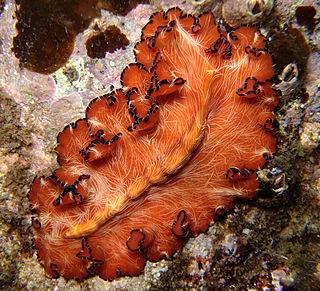
Pseudobiceros fulgor, also known the lightning worm, is a species of marine flatworm from the family Pseudocerotidae and belongs to the class Turbellaria. These flatworms are commonly found in the tropics of the Indo-Pacific region. They can be found in shallow coral reef environments.
Apidioplana apluda is a species of flatworm in the family Apidioplanidae. It can be found on the Great Barrier Reef as a symbiote of gorgonian corals.
